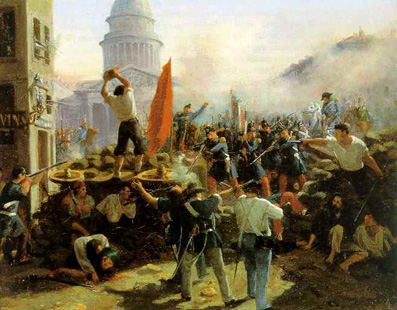 |
Peoples' movements and protests |
 |
|
Mobilizations16-17 century piracyThe slave uprising in HaitiThe Chartists1848The First internationalThe Social Democratic PartyThe Revolutions 1917-19General strike in Hong Kong 1925-26The occupation of FlintThe welfare statePeronismThe boom of the 60s-70s in EuropeSolidarnoscThe metal strike in São PauloThe Hyundai strikeBack to Labour MovementsBack to main page |
The Revolutions of 1848. The case of France
Labour movements had existed in the form of journeymen companionships since the Middle Ages. But these had little in common – they identified with their profession. During the French Revolution of 1789-94<LÄNK>, a common identity had begun to emerge in the form of ”the people” = the merged guilds. But since Napoleon’s military dictatorship had overthrown the ”people”, the journeymen had confined themselves to traditional forms of organization – common coffers and companion clubs that served as simple trade unions. What accelerated the development towards the ”labor movement” was the revolution of 1830. By then, the artisans of Paris had risen against a dictatorship under the slogan ”Freedom”. But when they demanded the right to negotiate wages and working conditions, the new revolutionary government declared that they must negotiate individually – union organization was said to be restrictive and was banned. During the 1830s, both secret trade unions and the language of the labour movement developed. The concept of ”capital exploitation of the workers” was first formulated in the printers’ magazine L’Artisan. In 1831, the silk weavers in Lyon rose and conquered the city for three days when the companies unilaterally terminated an agreement. A producer cooperative movement was developed with ambitions to organize the whole society; looking back on 1789-94, they called themselves ”republican”<LÄNK>, but republic here meant that ”the people” = the merged guilds would govern society – instead of the rich bourgeoisie that had sole power in the government. In 1848 this government fell for a new revolution and this time it was the workers of Paris who were the main force in the movement. They therefore had a great deal of self-confidence – but it would turn out that in France as a whole they fell short. When they demonstrated in June to protect their new employment protection, they were crushed by the army. The lesson of 1848 was that it was not easy to transform society. The conclusions were that long-term organization was required. It was from now on that the permanent organization became a main element in the workers' movement. Reading
|
